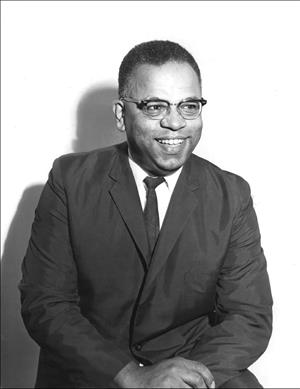Benjamin F. McAdoo was the first African American architect to maintain a practice in the state of Washington. He was a local civic leader and national advocate for the advancement of low-cost housing solutions. His Seattle area house designs achieved local acclaim.
A Distinguished, Prolific, Diverse Career
McAdoo's designs for modular housing, created for the United States Agency for International Development, demonstrated his interest in social change through civic action. During the three decades of his prolific and diverse architectural career, McAdoo designed churches, single and multifamily dwellings, as well as commercial and institutional works.
Born in Pasadena, California, McAdoo transferred from the University of Southern California to the University of Washington to complete his bachelors degree in architecture. Working nights and attending daytime classes, he graduated in 1946.
His first works were small in scale, including community churches, building renovations, and private residences. The private homes brought McAdoo popular recognition. His innovative designs were first published in The Seattle Times in July 1949. This publicity led to many other local commissions.
McAdoo’s Own Residence a Premier Example
His style, a synthesis of modernism and regionalism, proved popular within the expanding city. Like many other architects, McAdoo's personal residence (1957-1958) is a premier example of his ideal residential formula. (It is at 17803 28th Avenue S in Bothell.) McAdoo's house illustrates his approach to regionalism. The building's connection with the site is critical; its open structure and generous use of glass create an direct visual relationship between the built and natural environment. The strong horizontal lines of the building's profile accentuate this link with the relatively flat site. Such nontraditional residential architecture is still popular in the Seattle area.
Other residences designed by McAdoo include:
- the John P. Browning residence (1947), 2919 E Howell Street, Seattle;
- the Donald Hochberg residence (1953-1954), 4148 78th Avenue SE, Seattle;
- the Kenneth Ota residence (1955-1956), 10240 61st Avenue S, Seattle;
- the George H. Hage residence (1955-1956), 2648 SW 167th Place, Seattle.
A Civic Leader
McAdoo was also an outspoken civic leader. His interest in community led to an administrative position with the United States Agency on International Development. McAdoo led a housing program in Jamaica promoting a modular house design which could be easily assembled by unskilled workers. This design was successful and widely manufactured within that country. He subsequently developed similar programs while working in Washington, D.C. in the early 1960s.
He returned to Seattle in 1964 and, as president of the Seattle chapter of the NAACP, began broadcasting a weekly radio show focused on social issues. He maintained this post for four years.
Upon McAdoo’s return from Washington, D.C., the nature of his commissions changed. Much of his later work was institutional. His designs and renovations include:
- much work for the University of Washington including its Ethnic Cultural Center (1970-1972);
- Southcenter Branch of the King County Central Blood Bank (1967-1970);
- Seattle First National Branch Bank, Wedgwood (1970);
- Forward Thrust projects such as Fire Station No. 29 (1969-1972) at 2139 Ferry Avenue SW and the Queen Anne Pool (1974-1978) at 1920 1st Avenue W, both in Seattle.
McAdoo worked steadily until his death in 1981. His career, spanning critical decades of the civil rights movement, seamlessly joined social imperatives with architectural design.

